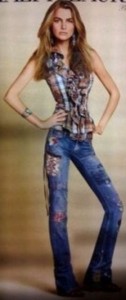Sep 13 2012
The Skinny on Altered Advertisements
In 2009, the widely known clothing company, Ralph Lauren, found themselves in hot water over the excessive retouching of a model used in an advertisement for their Blue Label jeans. Filippa Hamilton’s waist was whittled down until it appeared smaller than her head. While Photoshop has become a go-to tool in advertising, digitally enhancing someone to have impossible body proportions is definitely crossing the line. Suddenly, “normal” means looking a certain way that is only achievable with a computer program. In another case of photo-altering abuse, advertisements for CoverGirl were scolded when they displayed models with digitally enhanced eyelashes in an attempt to promote their new mascara products. To put things simply, it’s false advertising. What ends up on display for the public is not an honest representation. These are just a couple of examples in a world that is becoming increasingly obsessed with post-production perfection. The majority of images in the media may be skewed, but that doesn’t mean society’s perception of beauty should be too. At this time there are no regulations relating to the use of Photoshop in advertisement so it’s important to be aware of what is real and what is merely a product of post-processing.